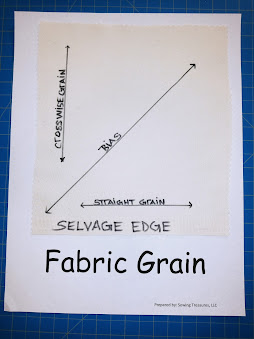Whenever I have a sewing class or private sewing lessons, I provide my students with the "Treasured Guidelines" folder.
I named it the "Treasured Guidelines" folder because I have researched and compiled, what I think is the most helpful information needed when learning sewing as a new skill. While it is not as comprehensive as it could be, it has all the necessary information to get anyone started.
One of the most important pieces of information that I cover during the first session of class, which is our introductory session, is sewing terms and their definitions. Since most, if not all, professions have their own set of language and/or terms; don't discount sewing, because we also have our own set of terms/language that only we can understand. It is helpful to know what these terms mean, so beginners in the sewing industry can understand the instructions in the pattern envelope, the sewing teacher, or even YouTube videos on sewing.
For the consideration of time, I will cover about 5 terms and definitions per blog post...this is the first of a series of more to come, let's get started:
Alterations: any changes made to a pattern or finished garment. Examples: Tailoring a suit to fit, hemming pants, a skirt, or dress, etc
Applique: a term used to describe attaching a small piece of fabric to create a desired design. It is usually done to add a form of fabric artwork. The smaller piece of fabric may be attached by using hand or machine stitching. In the photo, the lace applique is considered the applique piece that I added to the wedding dress sample that I made through Lenique's Originals, LLC, my design business.
Back-stitching: is sewing in reverse and then forward over the same stitches to lock the beginning and the end of the sewn seam. It prevents the stitching from coming un-sewn. In the following photo I stitched an example, when you press that button on your sewing machine, this is sewing in reverse to lock your stitches.
Basting/Tacking: large straight running stitches used to temporarily hold fabric layers together. Basting or tacking can be done by hand or machine stitching; use contrasting thread so the stitch can be removed easily; use the largest stitch possible on the sewing machine.
In the following photo, please don't be too critical of my hand-stitching skills, I know it's super crooked, and that was done on the second try, ugh! But, I'm sure you get the ideal!
Bias: is the most stretchable part of woven fabric, which is 45 degrees to the straight grain of woven fabric. Fabrics cut on the bias drape and flow nicely. There are special instructions you will need to know when working with bias cut garment pieces, if enough people request it, I will write a separate post.
In the photo, I show you a sample of the elements of woven fabric and what happens when you stretch the fabric on the 45 degree angle.
This concludes today's post. Next time, we will define clipping/notching, ease, facing, finishing seams, and fraying. I am going in the order of the alphabet, just in case you didn't notice 😁.
If you have any definitions or suggestion, please leave me a comment! Until next time!
















1 comment:
Hi Steph!
Post a Comment